<Back to Index>
- Samurai and Admiral Enomoto Takeaki, 1836
- Shinsengumi Fukuchou Hijikata Toshizō, 1835
PAGE SPONSOR
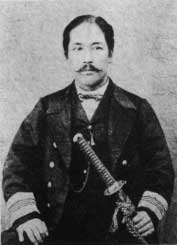
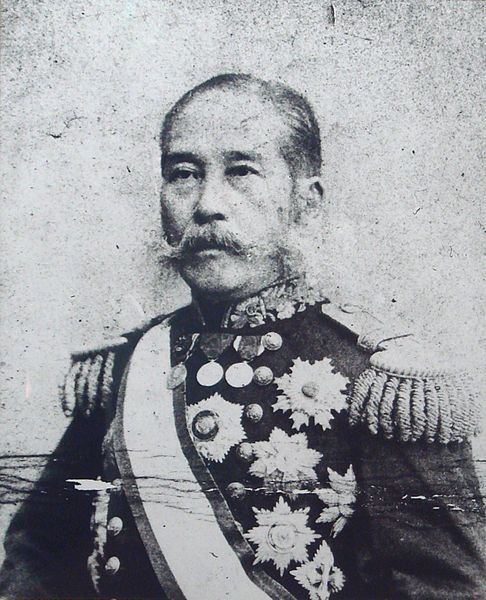
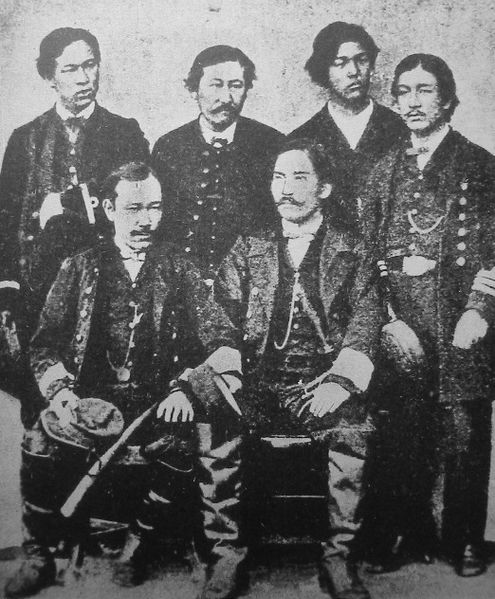
Viscount Enomoto Takeaki (榎本 武揚, 5 October 1836 – 26 October 1908) was a samurai and admiral of the Tokugawa navy of Bakumatsu period Japan, who remained faithful to the Tokugawa shogunate who fought against the new Meiji government until the end of the Boshin War. He later served in the Meiji government as one of the founders of the Imperial Japanese Navy.
Enomoto was born as a member of a samurai family in the direct service of the Tokugawa clan in the Shitaya district of Edo (modern Taito, Tokyo). Enomoto started learning Dutch in the 1850s, and after Japan's forced "opening" by Commodore Matthew Perry in 1854, he studied at the Tokugawa shogunate's Naval Training Center in Nagasaki and at the Tsukiji Warship Training Center in Edo.
At the age of 26, Enomoto was sent to the Netherlands to study western techniques in naval warfare and to procure western technologies. He stayed in Europe from 1862 to 1867, and became fluent in both the Dutch and English languages.
Enomoto returned to Japan onboard the Kaiyō Maru,
a steam warship purchased from the Netherlands by the Shogunal
government. During his stay in Europe, Enomoto had realized that the telegraph would be an important means of communication in the future, and started planning a system to connect Edo and Yokohama. Upon his return, Enomoto was promoted to Kaigun Fukusosai (海軍副総裁), the second highest rank in the Tokugawa Navy, at the age of 31. He also received the court title of Izumi - no - kami (和泉守).
During the Meiji restoration, after the surrender of Edo in 1868 during the Boshin War to forces loyal to the Satchō Alliance, Enomoto refused to deliver up his warships, and escaped to Hakodate in Hokkaidō with the remainder of the Tokugawa Navy and a handful of French military advisers and their leader Jules Brunet. His fleet of eight steam warships was the strongest in Japan at the time.
Enomoto hoped to create an independent country under the rule of the Tokugawa family in Hokkaidō, but the Meiji government refused to accept partition of Japan. On 25 December, the Tokugawa loyalists declared the foundation of the Republic of Ezo and elected Enomoto as president.
The next year, the Meiji government forces invaded Hokkaidō and defeated Enomoto's forces in the Naval Battle of Hakodate. On 18 May 1869, the Republic of Ezo collapsed, and Hokkaidō came under the rule of the central government headed by the Meiji Emperor.
After his surrender, Enomoto was arrested, accused of high treason and imprisoned. However, the leaders of the new Meiji government (largely at the insistence of Kuroda Kiyotaka) pardoned Enomoto in 1872, realizing that his various talents and accumulated knowledge could be of use. Enomoto became one of the few former Tokugawa loyalists who made the transition to the new ruling elite, as politics at the time was dominated by men from Chōshū and Satsuma, who had a strong bias against outsiders in general, and former Tokugawa retainers in particular. However, Enomoto was an exception, and rose quickly within the new ruling clique, to a higher status than any other member of the former Tokugawa government.
In 1874, Enomoto was given the rank of vice admiral in the fledgling Imperial Japanese Navy. The following year, he was sent to Russia as a special envoy to negotiate the Treaty of St. Petersburg.
The successful conclusion of the treaty was very well received in Japan
and further raised Enomoto's prestige within the ruling circles, and
the fact that Enomoto had been chosen for such an important mission was
seen as evidence of reconciliation between former foes in the
government.
In 1880, Enomoto became Navy Minister (海軍卿). In 1885, his diplomatic skills were again called upon to assisting Itō Hirobumi in concluding the Convention of Tientsin with Qing China. Afterwards, Enomoto held a series of high posts in the Japanese government. He was Japan's first Minister of Communications (1885 – 1888) after the introduction of the cabinet system in 1885. He was also Minister of Agriculture and Commerce from 1894 – 1897, Minister of Education from 1889 – 1890 and Foreign Minister from 1891 - 1892.
In 1887, Enomoto was ennobled to the rank of viscount under the kazoku peerage system, and was selected as a member of the Privy Council.
Enomoto was especially active in promoting Japanese emigration through settler colonies in the Pacific Ocean and South and Central America. In 1891, he established - against the will of the cabinet of Matsukata Masayoshi - a 'section for emigration' in the Foreign Ministry, with the task of encouraging emigration and finding new potential territories for Japanese settlement overseas. Two years later, after leaving the government, Enomoto also helped to establish a private organization, the 'Colonial Association', to promote external trade and emigration.
Enomoto died in 1908 at the age of 72. His grave is at the temple of Kisshō-ji, Bunkyo-ku, Tokyo.
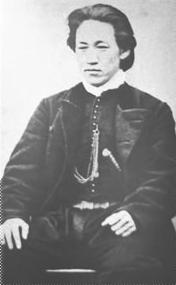
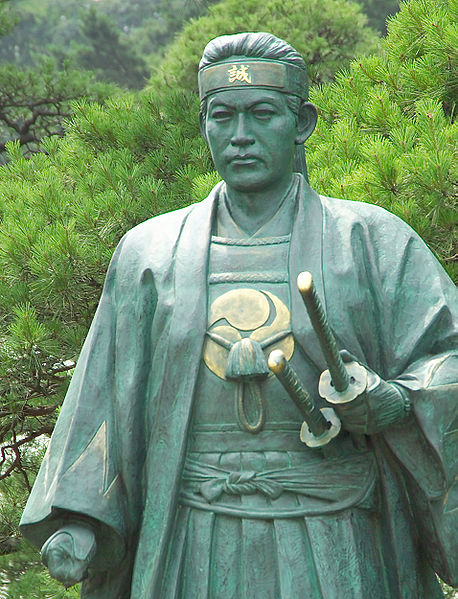
Hijikata Toshizō (土方 歳三, May 31, 1835 – June 20, 1869) was the vice commander of Shinsengumi, a great swordsman and a talented Japanese military leader who resisted the Meiji Restoration.
Hijikata Toshizō Yoshitoyo was born on May 31, 1835 in present-day Hino, a suburb of Tokyo. He was the youngest of six children, and his father, a well - to - do farmer, died shortly before his birth. Hijikata's mother also died when he was a young boy, and he was therefore raised by his older brother and sister - in - law.
He was apparently tall compared to the average Japanese men of the period, standing at approximately 165 cm, when the average height was 154 - 158 cm. He was said to be spoiled at an early age and was alleged to be mean to all but his friends and family. This changed when a 21 years old swordsman from the Aizu clan known for opposing the Reformists was forced to commit seppuku (ritual suicide). When Hijikata attended the man's funeral, he apparently cried in public.
Hijikata spent his youth selling his family's Ishida Sanyaku (medicine for treating injuries such as bruises and broken bones) while practicing his self taught kenjutsu. His brother - in - law, Satō Hikogorō, managed a Tennen Rishin - ryū dojo in Hino; through Sato, Hijikata met the later Kondō Isami and was formally enrolled at the Tennen Rishin - ryū's Shieikan in 1859. Although Hijikata himself never fully mastered the Tennen Rishin - ryū, it is said that he managed to develop the "Shinsengumi - Kenjutsu" fighting style from the Tennen Rishin - ryū.
In 1863, he and Kondō Isami formed the Shinsengumi. Kondō and two other men, Serizawa Kamo and Niimi Nishiki, became joint leaders of the group, and Hijikata served as one of the deputy leaders. Shinsengumi served as a special police force in Kyoto that fought against the Reformists under Matsudaira Katamori, the Daimyo of Aizu.
However, Serizawa and Niimi began fighting, drinking and committing extortion in Kyoto, which started to tarnish the reputation of Shinsengumi and earned the group the derogatory nickname of "Wolves of Mibu" (壬生狼, miburō). Hijikata found enough proof against Niimi in these matters and ordered him to commit seppuku. Serizawa and his followers, however, were assassinated, and Kondo became the sole leader of Shinsengumi with Yamanami Keisuke and Hijikata as his vice commanders.
The group grew to 140 men, which included a number of farmers and merchants whose livelihood would be threatened if the Tokugawa Shogunate was overthrown. The regulations set up by Shinsengumi within Kyoto were strict and Hijikata was known to be harsh in enforcing them, hence his nickname: "The Demon of the Shinsengumi". Even within the Shinsengumi itself, regulations were strictly enforced by Hijikata. Deserters and traitors were forced to commit seppuku; this happened to Yamanami (one of Hijikata's old friends) when he tried to leave Shinsengumi in 1865.
Hijikata owned a sword made by renowned swordsmith Izumi - no - Kami Kanesada (和泉守兼定) that was forged during the Edo period.
Together with the rest of the Shinsengumi, Hijikata became a hatamoto in 1867. He was given the rank of yoriai (yoriai - kaku 寄合格) in early 1868.
After Kondo surrendered to the Imperial Loyalist Army and was executed on May 17 (lunar calendar April 25) 1868, Hijikata led Shinsengumi on their final battles against the new government. After a time in Aizu, he went to Sendai, where he joined up with Enomoto Takeaki's fleet. He knew he was fighting a losing battle, and told the physician Matsumoto Ryojun that "I am not going to battle to win. With the Tokugawa government about to collapse, it would be a disgrace if no one is willing to go down with it. That is why I must go. I will fight the best battle of my life to die for the country".
In October 1868, Hijikata and Ōtori Keisuke led Shogunate forces to occupy the fortress of Goryōkaku in the Battle of Hakodate, and continued to eliminate local resistance. When the short lived Ezo Republic was founded in December, Hijikata was made a vice minister of the Army. Imperial troops continued to attack by land and sea. In the final conflict of the revolution, on June 20 (lunar calendar May 11), 1869, Hijikata was killed while in combat on horseback by a bullet that shattered his lower back. A week after his death, the Goryōkaku fortress was taken, and the military of Ezo Republic surrendered to the Meiji government on May 17, 1869.
It is unknown where Hijikata was buried, but a memorial gravestone stands near Itabashi Station in Tokyo, next to Kondō Isami's. The death poem entrusted to Ichimura Tetsunosuke shortly before Hijikata's death reads:
Though my body may decay on the island of Ezo, My spirit guards my lord in the east.
The Shinsengumi have become a popular subject for films, television, and manga and anime, ranging from historical drama to comedy and romance. As a leader of the group, Hijikata is usually a prominent character in such productions. Hijikata is depicted in the 1999 film Gohatto ('Taboo') (played by Takeshi Kitano), and the 2004 NHK Taiga drama series Shinsengumi! (including the single episode sequel Shinsengumi!: Hijikata Toshizo Saigo no Ichinichi). He is the protagonist in Morita Kenji's manga Getsumei Seiki, and in Mibu Robin's Baragaki ("Red Demon"). Hijikata is also featured in a number of other anime and manga series, including Peace Maker Kurogane; Kaze Hikaru; Shura no Toki; Gintama (a comedy / alternate universe version); Hell Girl and the popular otome game / anime series Hakuouki: Shinsengumi Kitan. Hijitaka is also a supporting character in Shin Teito Monogatari, the prequel to the bestselling historical fantasy novel Teito Monogatari (Hiroshi Aramata).